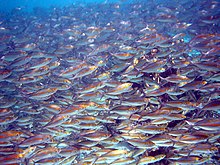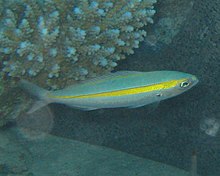Goldband fusilier
| Goldband fusilier | |
|---|---|

| |
| School of goldband fusiliers | |
| Scientific classification | |
| Domain: | Eukaryota |
| Kingdom: | Animalia |
| Phylum: | Chordata |
| Class: | Actinopterygii |
| Order: | Perciformes |
| Family: | Caesionidae |
| Genus: | Pterocaesio |
| Species: | P. chrysozona
|
| Binomial name | |
| Pterocaesio chrysozona (G. Cuvier, 1830)
| |
| Synonyms[2] | |
| |
The gold-band fusilier (Pterocaesio chrysozona) also known as the yellow-band fusilier or black-tipped fusilier, is a species of marine
Taxonomy
The goldband fusilier was first formally
Description
The goldband fusilier has a
Distribution and habitat
The goldband fusilier is found in the tropical Indian and Western Pacific Oceans. Its range extends along the eastern coast of Africa from Mozambique north to the Red Sea and eastwards across the Indian Ocean, although it is absent from the northern Arabian Sea and the Persian Gulf. In the Pacific Ocean is reaches east as far as the Solomon Islands, north to the Yaeyama Islands and south to Australia.[1] In Australia they are found around the coast from the Dampier Archipelago in Western Australia to Sydney.[7] They are at depths between 5 and 35 m (16 and 115 ft) among coral reefs, seagrass, along outer reef slopes and around pinnacles in deep lagoons.[8]
Biology
Goldband fusiliers are a non-


Fisheries
Goldband fusiliers play a minor role in commercial fisheries. In the Philippines, they are sometimes caught and marketed fresh using
Notes
- ^ . Retrieved 20 November 2021.
- ^ a b c d Froese, Rainer; Pauly, Daniel (eds.) (2021). "Pterocaesio chrysozona" in FishBase. June 2021 version.
- ^ Eschmeyer, William N.; Fricke, Ron & van der Laan, Richard (eds.). "Species in the genus Pterocaesio". Catalog of Fishes. California Academy of Sciences. Retrieved 7 July 2021.
- ^ a b c d Kent E. Carpenter (1988). FAO Species Catalogue Volume 8 Fusilier Fishes of the World (PDF). FAO Rome. pp. 52–53.
- ^ Eschmeyer, William N.; Fricke, Ron & van der Laan, Richard (eds.). "Genera in the family Lutjanidae". Catalog of Fishes. California Academy of Sciences. Retrieved 7 July 2021.
- ^ Christopher Scharpf & Kenneth J. Lazara, eds. (5 January 2021). "Order LUTJANIFORMES: Families HAEMULIDAE and LUTJANIDAE". The ETYFish Project Fish Name Etymology Database. Christopher Scharpf and Kenneth J. Lazara. Archived from the original on 12 April 2021. Retrieved 7 July 2021.
- ^ a b Dianne J. Bray. "Pterocaesio chrysozona". Fishes of Australia. Museums Victoria. Retrieved 7 July 2021.
- ^ a b Nguyen, N.T. and V.Q. Nguyen (2006). Biodiversity and living resources of the coral reef fishes in Vietnam marine waters. Science and Technology Publishing House, Hanoi.
References
- Carpenter K.E. (1988) ISBN 978-92-5-102746-2.


